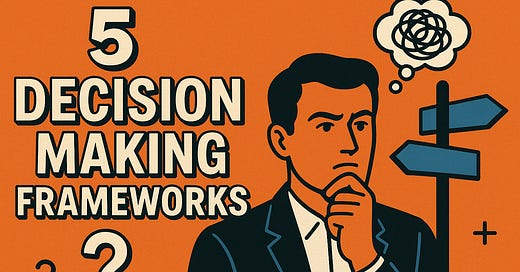5 Decision-Making Frameworks That Actually Work
Decision-making frameworks don’t replace intuition, they help you hear it more clearly.
If you like this article, feel free to click the ❤️ or 🔄 button on this post so more people can discover it on Substack 🙏
One of the most important skills we can develop in leadership and in life is learning how to make great decisions—especially when there’s no obvious answer.
Do I take the new job or stay where I’m comfortable?
Do I end the relationship or keep trying?
Do we pivot the business or double down on the original vision?
These are the moments when uncertainty spikes, and our mind can become a battlefield of competing thoughts, fears, and projections. And here’s the truth:
Most of us never learned how to make decisions intentionally.
We either loop in overthinking, outsource our choices to others, or react impulsively and hope for the best.
The greatest leaders treat decision-making like a skill—not just something that happens.
That’s where frameworks come in. Over the past decade coaching founders, and teams, I’ve found that a great decision-making framework doesn’t give you the answer—it gives you clarity.
Below are five great tools for navigating big decisions with more confidence and clarity:
1. The Best Friend Test
Best for: Accessing your own wisdom from a different perspective
Imagine your best friend came to you with the exact same decision you’re facing. What would you tell them?
This technique works because we tend to give wiser, more compassionate advice to others than we do to ourselves.
So if your friend was dating someone kind but fundamentally incompatible, would you tell them to stay just because it’s convenient? Probably not.
This framework flips the script: What would you say if you weren’t so close to it?
2. The 10-10-10 Rule
Best for: Future-oriented thinking and breaking out of short-term bias
This one’s from Suzy Welch, and it's as simple as it is profound. Ask yourself:
How will I feel about this decision in 10 minutes?
In 10 months?
In 10 years?
It stretches your time horizon and helps you balance emotional urgency with long-term wisdom.
Say you’re thinking of quitting your job on a tough day.
In 10 minutes: You might feel relieved.
In 10 months: You might be scrambling financially.
In 10 years: You might be proud you finally took a risk—or regret not planning better.
The 10-10-10 method won’t make your decision easy, but it will make it informed.
3. Yes-Yes-No
Best for: Filtering for aligned hell-yes decisions
From Derek Sivers’ philosophy of decision-making, this approach gives you a clear rubric:
Yes with your head (It makes logical sense)
Yes with your heart (It feels aligned)
If either one is a no, it’s a No
Let’s say someone offers you a speaking gig for decent money, but the audience doesn’t feel ethically aligned. Your head says yes (easy money, exposure), but your heart says no (you don’t align with this company). That’s a no.
It’s a simple way to honor your energy and avoid burnout from half-hearted yeses.
My friend has a nice addition to this framework. He says, "If your head is a yes, and your heart is a yes, and your fear says no, then it is definitely a yes."
4. The Sedona Method
Best for: Emotional clarity when you’re stuck or triggered
This method starts with a powerful question: Can I let this go?
It’s about getting underneath your thinking and addressing the emotional charge behind indecision.
Let’s say you’re debating whether to end a business partnership. Instead of cycling through pros and cons for days, you pause and ask:
What am I feeling right now?
Is this feeling coming from fear, control, or desire?
Can I let that go—even just for now?
By releasing the emotional grip, you can see the situation with more objectivity. The Sedona Method doesn’t tell you what to do, but it clears the emotional fog so you can connect to your values and instincts more clearly.
Click here for a more detailed analysis.
5. The Vanishing Options Framework
Best for: breaking out of narrow thinking when you feel trapped between limited choices.
The Vanishing Options framework is a decision-making tool developed by Chip and Dan Heath in their book Decisive. It addresses a really common trap: when we're facing a big decision, we tend to think in either/or terms — like "Should I stay at my job or quit?" — and get stuck between just two options.
The Vanishing Options Test works like this:
Force yourself to eliminate your current options. Imagine that every option you're considering vanishes. It's illegal, it's impossible, it's off the table.
Ask: "If none of the current options were available, what would I do instead?" This forces you to think beyond your current framing. It opens up new ideas, possibilities, or strategies you hadn't considered because you were stuck between a few obvious choices.
Why it works:
It breaks narrow framing (where you only look at a few obvious solutions).
It triggers creativity because you're no longer evaluating only the first things that came to mind.
It reduces regret later because you explore a fuller range of possibilities.
Final Thought:
There’s no perfect framework that will make all decisions easy. But when you combine emotional clarity, time perspective, intuition, and objectivity—you give yourself a fighting chance to move forward without regret.
Decision-making frameworks don’t replace intuition, they help you hear it more clearly.





